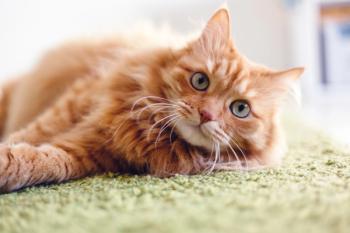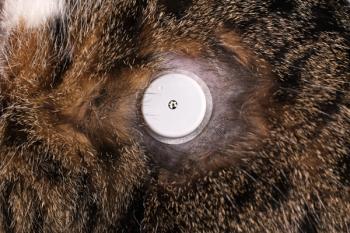
Feline hyperthyroidism (Proceedings)
Feline hyperthyroidism is a common endocrinopathy of the cat.
Background
This is a common endocrinopathy of the cat. The disease is most common in older cats but there has been one report of congenital hyperthyroidism in a kitten. The most common histologic lesion is multinodular adenomatous goiter of the thyroid gland. In most cats this is bilateral although unilateral lesions can occur. Other less frequently identified benign lesions include adenomas and adenomatous hyperplasia. Benign lesions occur in over 95% hyperthyroid cats. Malignant tumors occur in less than 5% of hyperthyroid cats and consist of papillary and follicular carcinomas.
Etiology
The etiology of this disease is currently unknown but several breed, environmental, dietary and physiologic factors have been studied. Siamese and Himalayan cats may have a decreased incidence. Dietary factors that have been studied and have failed to play a role include dietary iodine and selenium. Dietary factors that likely play a role include feeding canned diets particularly those containing liver and giblets or fish. Canned foods also contain phthalates, resorcinol, polyphenols, polychlorinated biphenyls and soy isoflavones that may act as goitrogens. Cats that live indoors and those that use litter also have an increased incidence. The stimulation of growth factors and suppression of inhibitory G-proteins may also play a role.
History
The most common historical findings include weight loss, polyphagia, polydipsia, polyuria, hyperactivity, dermatologic abnormalities, respiratory distress, vomiting and diarrhea. Heat intolerance and seizures can also occur. An 'apathetic hyperthyroidism' has been described and occurs in less than 15% of hyperthyroid cats. These cats are lethargic, weak and anorexic so the diagnosis may be missed. It is likely these cats displayed some of the more classic signs of hyperthyroidism earlier in their disease but that the catabolic affects of the disease have resulted in this atypical manifestation.
Clinical Findings
On physical examination these animals nay become easily stressed with handling. They are often thin with generalized muscle wasting and their coat may appear unkempt. Rarely, they appear in status epilepticus or with cervical ventroflexion. Mucous membranes may be tacky or dry and a skin tent noted. The thyroid nodule is almost always palpable and affects both lobes in most cats. Cats may have an elevated temperature, tachycardia, a gallop rhythm, a heart murmur, premature beats, tachypnea and open-mouth breathing. Because these cats may be hypertensive they may also have retinal hemorrhages or detached retinas.
Diagnostic Evaluation
Routine laboratory evaluation may show a mild polycythemia and a stress leukogram. The most common biochemical finding is elevations in liver enzymes. Alanine transferase is most commonly elevated but alkaline phosphatase may also be elevated. Azotemia is fairly common in these cats and may be prerenal, due to hyperthyroidism, or renal, due to concurrent intrinsic renal disease. It is not uncommon to find urine that is not maximally concentrated due to the effects of thyroid hormone or concurrent renal disease.
Some cats with hyperthyroidism are also hypertensive so blood pressure should be evaluated in any cat suspected to have the disease. The most common electrocardiographic findings are tachycardia, increased R-wave amplitude and premature contractions (atrial and ventricular). On echocardiography left ventricular hypertrophy, a thick interventricular septum, left atrial dilation, left ventricular dilation and increased fractional shortening may be seen.
The diagnosis of hyperthyroidism is typically made based on the historical, physical and clinical findings mentioned previously in addition to evaluation of serum thyroxine levels. Thyroxine (T4) is the primary iodothyronine, or thyroid hormone, released from the thyroid gland. Tri-iodothyronine (T3) is also released in a much smaller quantity. Thyroxine consists of both free and bound fractions. Ninety-nine percent of thyroxine is bound and only 1% free. It is the free fraction of T4 that can enter cells where it is converted to the biologically active portion, T3 as well as rT3. Total serum thyroxine (TT4) consists of free and unbound fractions and is usually measured with human radioimmunoassay's (RIA) validated for the cat. There are in-house ELISA's that measure TT4 but these are less sensitive than the RIA's used by most commercial laboratories. Total tri-iodothyronine (TT3) can also be measured but it is not recommended because it is much less sensitive than TT4.
The vast majority of cats with clinical signs and a palpable thyroid mass have an increased TT4. A few cats that have other non-thyroidal illness or early hyperthyroidism might have a normal TT4. If early hyperthyroidism is suspected in a cat with a normal TT4, the TT4 can be retested in 1 to 2 weeks. Another option is to measure free T4. Serum thyroxine can be affected by the quantity of carrier proteins, alterations in metabolism, the ability to transport thyroxine into cells and binding of T4 within the cells. These are the mechanisms that may alter TT4 levels in non-thyroidal illness and are the basis for the recommendation of measurement of free T4. Tests using equilibrium dialysis are recommended. This test is more sensitive than TT4 for diagnosing hyperthyroidism but is also less specific. This decreased specificity is why it is not recommended as a screening test.
A few cats may still be problematic and the T3 suppression test can be used in which thyroid hormone (T3, levothyroxine) is administered to suppress TSH and subsequent T4 production. Baseline serum TT3 and TT4 are measured and then the cat is given thyroid hormone three times a day for 2 days. A final dose is given the morning of the test and TT4 and TT3 are measured 2 to 4 hours after the last dose. Normal cats should have a decreased TT4 but because of the autonomous function of the thyroid gland, TT4 in hyperthyroid cats decreases little if at all. Serum TT3 is measured to evaluate successful administration of T3 and should increase.
Thyrotropin-releasing hormone (TRH) is released by the hypothalamus and increases production of TSH by the pituitary and subsequent T3, T4 and rT3 from the thyroid gland. A baseline TT4 is measured, thyrotropin-releasing hormone administered IV and serum TT4 measured 4 hours later. In a normal cat TT4 should increase twofold or more but hyperthyroid cats stimulate less than 50% above baseline because the chronically elevated T4 and T3 suppress TSH secretion so the pituitary is less responsive to exogenous TRH.
Radionuclide imaging can also be used. The thyroid gland concentrates certain substances such as radioactive iodines and technetium. Radioactive iodines (I-123, I-131) can be used but are less practical because of the greater radiation exposure to humans, longer elimination half lives (13 hours for I-123, 8 days for I-131) and longer time to acquire images (4 hours for I-123, 24 hours for I-131). Pertechnetate is structurally similar to iodine so it is concentrated in the thyroid gland like iodine. It is inexpensive, has a shorter half-life (6 hours), only emits low energy gamma particles and imaging can begin 20 minutes after IV administration. Technetium 99m, and the other radionuclides, are given intravenously and the radioactivity measured by a camera and recorded on film. Radioactive particles concentrate in the thyroid, salivary glands and gastric mucosa of the normal cat. In a normal cat the radio intensity should be 1:1 between the salivary glands and thyroids. The salivary glands and thyroid lobes should also be similar in size. In the hyperthyroid cat the affected lobe(s) will be more radio intense as well as enlarged. Radionuclide imaging can be used to determine if the thyroid gland(s) is hyperfunctional, disease is unilateral or bilateral and whether any ectopic tissue is present. This can aid in therapeutic decisions. We discussed that in some cases in which TT4 and FT4 are inconclusive, radionuclide imaging can be used. There are also other types of masses that can occur in the cervical region that might be confused with a thyroid tumor. These should not concentrate radionuclide. Differentiating unilateral (< 20%) from bilateral might aid in determining the best treatment modality. In cats with unilateral disease, surgery may be the treatment of choice so that only the abnormal thyroid lobe is removed. Subsequently, the other atrophied lobe can regain function and maintain a euthyroid state. With bilateral disease there are more treatment options including oral therapy, surgery or radioactive iodine. There have been a few cases of cats with bronchogenic carcinoma that have increased uptake of radionuclide but there can be increased uptake by metastatic thyroid malignancy in the neck, cranial mediastinum and pulmonary parenchyma. This is uncommon, but these cats might not be the best surgical candidates because functional thyroid tissue may be left and surgery would fail to control the disease.
Ultrasound can be used to evaluate thyroid gland size. The normal thyroid gland is long and thin. In hyperthyroid cats, the length of the lobe does not necessarily change but they become thickened and more hypoechoic. Ultrasound of the thyroid glands requires a great deal of experience with this modality. There are much easier, more readily available diagnostic tests for this disease.
Treatment
The most commonly considered long term treatment options for this disease are oral medications, radioactive iodine and surgery. Methimazole is a thiourylene that is a reversible inhibitor of organification of iodide and the formation of T3 and T4. It can be given orally or topically in a pluronic lecithin organogel formulation. Methimazole is useful in determining a cat's tolerance to a euthyroid state. This is particularly concerning in cats because of another common geriatric disease, renal insufficiency or failure. Hyperthyroid cats can be PU/PD which can increase renal blood flow and glomerular filtration rate as well as decrease urine specific gravity. In hyperthyroid cats, the increased renal blood flow (RBF) may be maintaining the glomerular filtration rate (GFR) and making these cats euthyroid, or hypothyroid, can decrease RBF/GFR to the detriment of the kidneys. Any hyperthyroid cat with azotemia or less than maximally concentrated urine is a good candidate for a methimazole trial. Nuclear scintigraphy and iohexol clearance studies can also be done to determine GFR in cats. Cats with abnormal GFR based on these studies are probably not ideal candidates for permanent, irreversible forms of treatment such as surgery and radioactive iodine. Methimazole can also be used prior to surgery or radioactive iodine to stabilize patients. Cats with hyperthyroidism suffer from weight loss, cachexia, anxiety, vomiting and cardiac disturbances that might make prolonged hospitalization for radioactive iodine or surgery more of a risk. Methimazole requires administration once to twice daily. Typically cats are started at 2.5 mg once or twice daily for two weeks, oral or transdermal. The TT4 can be repeated 4 to 6 hours post pill and if still increased, the dose increased to 5 mg/day. A CBC, chemistry panel and urinalysis should also be rechecked at 2 weeks and monthly for the first 3 months to evaluate for possible side effects. Side effects include lethargy, vomiting, anorexia, facial pruritis, hepatotoxicity and blood dyscrasias (granulocytes, platelets). Facial pruritis, blood dyscrasias and hepatotoxicity are reasons to discontinue therapy. In these animals other treatment methods should be considered. Transdermal therapy is associated with less gastrointestinal upset but other side effects can occur.
Surgery is recommended for cats that can tolerate permanent therapy, those that do not tolerate oral therapy and cats without metastatic disease. Previously we discussed using methimazole pre-operatively to stabilize the hyperthyroid cat prior to anesthesia and surgery. Beta blockers have also been administered pre-operatively in cats with tachyarrhythmias. Surgery involves removal of the affected thyroid lobe(s) and preservation of the external parathyroid glands. The internal parathyroid glands are found within the thyroids and removed at the time of surgery. Modified intra and extracapsular techniques are utilized with or without transplantation of the external parathyroid gland(s) to decrease the incidence of post-surgical hypoparathyroidism. Hypoparathyroidism is more common with bilateral than unilateral thyroidectomy. In some cases, hypocalcemia may last just a few hours but in others it may take days to weeks to normalize. Permanent hypoparathyroidism can also occur and is more common with bilateral thyroidectomy. Serum calcium is monitored daily for 1 week post-operatively and if calcium decreases below 6.5 g/dL treatment with intravenous (10% calcium gluconate initially followed by oral calcium and calcitriol (vitamin D3). The goal is to keep calcium low normal so endogenous production of parathyroid hormone occurs. Calcium is weaned first followed by vitamin D3 over several months. Some cats require life long therapy. Other complications of surgery include laryngeal paralysis, Horner's syndrome, permanent hypothyroidism and recurrence of hyperthyroidism. Laryngeal paralysis and Horner's are usually transient. Hypothyroidism may also be transient as remnant or atrophied thyroid tissue begins producing thyroid hormones. Hypothyroidism is rarely treated except for in cases of extreme lethargy and dermatologic conditions. Recurrence of hyperthyroidism occurs most often in the presence of ectopic tissue or with incomplete removal of abnormal tissue.
Radioactive iodine is also an option for long term control of hyperthyroidism. Again, the thyroid normally concentrates iodine within the gland. Different facilities use different dosing methods. Most facilities use the clinical signs, TT4 and size of the thyroid to determine whether a low, moderate or higher dose should be given. Another technique involves giving low dose I-131 to determine the 'size' of the thyroid. Using this information and the known pharmacokinetics of radioactive iodine, a dose specific for the cat is calculated. Another approach is to just administer a high dose of I-131. The first two approaches result in euthyroidism with the first treatment 60 – 80% of the time and hypothyroidism is relatively uncommon. High dose I-131 has a high success rate but a much higher incidence of permanent hypothyroidism. The radioactive iodine, typically I-131, is administered IV or SC and concentrated in the thyroid gland where the rays typically do most of the damage. Normal thyroid cells take up little of the iodine and are spared. Cells can die off over several months prolonging the effects of treatment. Because the half life of I-131 is 8 days, cats must remain hospitalized following treatment in order to limit exposure to humans. They are hospitalized until surface radioactivity levels are less than 45 mR/hr. Cats are typically hospitalized for 7 to 14 days, longer with higher doses. Once they go home owners are instructed to limit contact with the cat for another 3 weeks. People younger than 18 or pregnant should have no contact; people 18 – 45 should stay 6 feet away and people over 45 at least 3 feet. Because elimination of I-131 is through the kidneys, extra precautions should be taken when cleaning the litter box. Radioactive iodine is the treatment of choice for thyroid malignancy because it concentrates in local and metastatic tissue. Malignant cells concentrate iodine less efficiently so higher doses are often used. Thyroid levels are checked 2 to 3 months after therapy and should be within the reference range.
Percutaneous ethanol injections and radiofrequency heat ablation performed via ultrasound have been used as well. Euthyroidism is temporary. Side effects include laryngeal paralysis (ethanol injections) and Horner's syndrome (heat ablation). Due to the relatively high incidence of side effects and limited efficacy, these techniques are not routinely recommended.
References
Peeters ME, Timmermans-Sprang EP, Mol JA. Feline thyroid adenomas are in part associated with mutations in the G(s alpha) gene and not with polymorphisms found in the thyrotropin receptor. Thyroid. 2002 Jul;12(7)571-5.
Hammer KB, Holt DE, Ward CR. Altered expression of G proteins in thyroid gland adenomas obtained from hyperthyroid cats. Am J Vet Res. 2000 Aug;61(8):874-9.
Olczak J, Jones BR, et al. Multivariate analysis of risk factors for feline hyperthyroidism in New Zealand. N Z Vet J. 2005 Feb;53(1):53-8.
Edinboro CH, Scott-Montcrieff JC, et al. Epidemiologic study of relationships between consumption of commercial canned food and risk of hyperthyroidism in cats. J Am Vet Med Assoc. 2004 Mar;224(6):879-86.
Martin KM, Rossing MA, et al. Evaluation of dietary and environmental risk factors for hyperthyroidism in cats. J Am Ve Med Assoc. 2000 Sep 15;217(6):853-6.
Kass PH, Peterson ME, et al. Evaluation of environmental, nutritional, and host factors in cats with hyperthyroidism. J Vet Intern Med. 1999 Jul-Aug;13(4):323-9.
Newsletter
From exam room tips to practice management insights, get trusted veterinary news delivered straight to your inbox—subscribe to dvm360.




